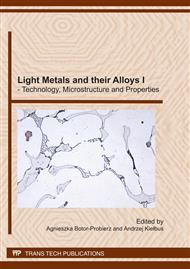p.35
p.39
p.49
p.55
p.63
p.75
p.83
p.91
p.99
Microstructure and Properties of Sand Casting Magnesium Alloys for Elevated Temperature Applications
Abstract:
It is required of sand casting magnesium used for aircraft industry to be, among others, increasingly creep-resisting. This paper describes microstructure and properties of chosen magnesium sand casting alloys, intended for usage at ambient and elevated temperature. The first part describes the most popular magnesium alloy Mg-9Al-1Zn (AZ91), which, due to the presence of Mg17Al12 phase in its structure, can be used only up to the temperature of ~120°C. The second part describes Mg-5Y-4RE-Zr (WE54) alloy, which can be used at the temperature of up to ~250°C. Unfortunately, its usage is very limited due to high price. The third part characterizes Mg-3Nd-1Gd-Zr (EV31A) alloy, which has properties similar to Mg-5Y-4RE-Zr alloy, but lower price. This paper also discusses the potential applications of these alloys.
Info:
Periodical:
Pages:
63-74
Citation:
Online since:
June 2011
Authors:
Keywords:
Price:
Сopyright:
© 2011 Trans Tech Publications Ltd. All Rights Reserved
Share:
Citation:


